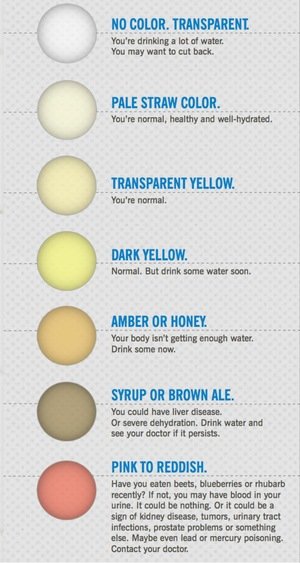The doctors tell us what Pee and Poo Color Says About Your Health
Out of the blue I passed bright red pee. I freaked, thinking it was a sign of terminal disease. Then I remembered the roasted beetroot tarts served at the party the night before – so delicious I’d eaten three! Beetroot, artificial colours, vitamin supplements and medications can change the colour of your urine or bowel motions. Knowing which colour changes are due to food or medicines can save you worry, or provide an early alert to get to the doctor.
Beeturia
Beeturia is the term for passing red urine after eating beetroot. The red colour comes from a pigment called betalain, also in some flower petals, fruit, leaves, stems and roots. Concentrated beetroot extract, called Beet Red or additive number 162 on food labels, can be added to “pink” foods, such as ice-cream.Report this Advertisement Whether betalain turns your pee red or not depends on the type of beetroot, amount eaten and how it’s prepared, because betalain is destroyed by heat, light and acid. How much betalain enters your digestive tract depends on stomach acid and stomach emptying rate (people taking medications to reduce stomach acid may be prone to beeturia). Once in the blood stream, betalain pigments are filtered out by the kidneys. Most is eliminated two to eight hours after eating. Persistent red urine can be due to blood loss, infection, enlarged prostate, cancer, cysts, kidney stones or after a long-distance run. If you see red and have not been eating beetroot, see your doctor.
What should your pee look like?
Normal pee should be the colour of straw. If your pee is so colourless that it looks like water, you probably drank more than you needed. Very dark yellow pee usually means you are a bit dehydrated and need to drink more water.
Strange pee colours due to food, drugs or disease
Pee the colour of syrup or molasses needs medical investigation. While it could be due to extreme dehydration, it can be a sign of liver diseases such as hepatitis and cirrhosis, where a build up of bilirubin spills into your pee. Bilirubin is a breakdown product of red blood cells; it’s also responsible for poo’s normal brown colour. Pee can turn bright orange or yellow when taking beta-carotene or vitamin B supplements, especially large doses of riboflavin (vitamin B2). These supplements are water soluble. What your body can’t use or store gets filtered out via your kidneys and into pee. Medications including phenazopyridine (for urinary tract infections), rifampin (antibiotic for treating tuberculosis and Legionnaire’s disease), warfarin (blood thinner) and some laxatives can also change pee colour. If you pass blue or green pee, it’s most likely due to food colouring or methylene blue used in some diagnostic test procedures and some drugs. But a range of medications can also trigger blue or green urine. These include antihistamines, anti-inflammatories, antibacterials, antidepressants, some nausea drugs or those for reducing stomach acid. Rare genetic conditions Hartnup disease and Blue diaper syndrome cause blue-green urine. So see your doctor if it persists or it happens in an infant. You should never see purple pee, but hospital staff might. “Purple urine bag" syndrome happens in patients with catheters and infections or complications. The catheter or bag turns purple due to a chemical reaction between protein breakdown products in urine and the plastic. Occasionally, pee can be frothy. It’s a normal reaction if protein intake is high and pee comes out fast. It is more likely if you consume protein powders or protein supplements. Excess protein can’t be stored in the body so the nitrogen component (responsible for the froth) gets removed and the kidneys excrete it as urea. See your doctor if the frothiness doesn’t go away or gets worse, as protein can leak into pee if you have kidney disease.
Poo colours of the rainbow
Normal poo colour ranges from light yellow to brown to black. The colour is due to a mix of bile, which starts off green in the gall bladder, and bilirubin a yellow breakdown product from red blood cells. Poo can turn green after consuming food and drink containing blue or green food colouring, or if food travels too fast through the gut and some bile is still present. Poo that is yellow, greasy and smells really bad signals food malabsorption. If this colour is associated with weight loss in an adult or poor growth in a child, see a doctor to rule out gut infections such as giardia or medical conditions like coeliac disease. Very pale or clay-coloured poo can happen when taking some anti-diarrhoeal medications, or when digestive problems affect the liver, gut, pancreas or gall bladder. At the other extreme of the colour spectrum, black poo could be a serious medical issue due to bleeding in the stomach or upper gut. Or it could be a harmless side-effect from taking iron supplements, or eating lots of licorice. Red poo can also be a serious medical issue due to bleeding in the lower gut, or from haemorrhoids, or harmless after having large amounts of red food colouring. If you don’t know what colour your pee or poo is, take a look. If you see a colour that’s out of the ordinary and you haven’t eaten anything unusual, take a picture and make an appointment to show your GP. Clare Collins, Professor in Nutrition and Dietetics, University of Newcastle; Kristine Pezdirc, Research Associate | Post-doctoral Researcher, University of Newcastle, and Megan Rollo, Postdoctoral Research Fellow, Nutrition & Dietetics, University of Newcastle This article was originally published on The Conversation. Read the original article.


Upvoted
Hi! This post has a Flesch-Kincaid grade level of 9.7 and reading ease of 66%. This puts the writing level on par with Michael Crichton and Mitt Romney.